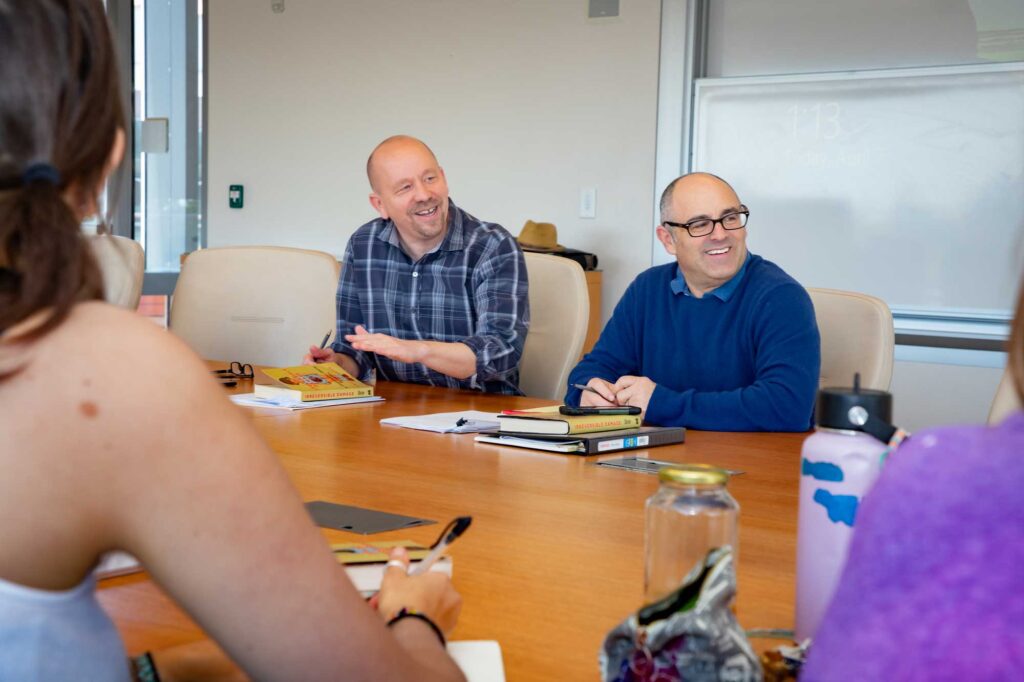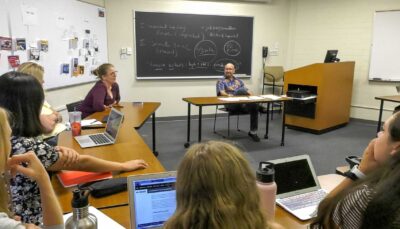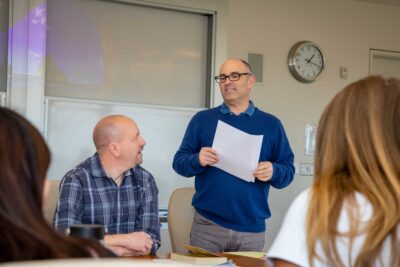Three classes and six faculty explore interdisciplinary and student-driven curricula in political science, modern languages, and sociology and government
 Claremont McKenna College Professor Jon Shields and Pitzer College Professor Phil Zuckerman
Claremont McKenna College Professor Jon Shields and Pitzer College Professor Phil Zuckerman
Claremont, Calif. (April 17, 2023)—In a co-taught Pitzer class, education is an experiment in collaboration. This year, several dynamic professor duos have reached across subjects, disciplines, and even the Claremont Colleges to enrich their students’ academic experience and hands-on engagement.
Many of the world’s challenges and issues are complex and can’t be solved by a single discipline or viewpoint. Instead, as faculty explained in interviews, co-taught classes are helping participants to consider (or reconsider) ideas more deeply from various perspectives.
“One of the Most Pitzer Things You Can Imagine”
In “U.S. Campaigns and Elections,” Professor of Chicano Studies/Political Studies Adrian Pantoja and Professor of Political Studies Rachel VanSickle-Ward show students how to understand why individuals participate in elections. Although both are political scientists, VanSickle-Ward specializes in gender and Pantoja in race and ethnicity—emphasizing marginalized identities in the discussion.
“Co-teaching across disciplines is one of the most Pitzer things you can imagine,” said VanSickle-Ward. “The most important questions we ask in life are never going to be answered by just one perspective.”
During the course last fall, students not only studied politics and electoral data, they pursued civic engagement by working on a campaign and participating in the electoral process. From door-to-door canvassing to phone banking to social media, students took ownership of democracy and put academia into action. Co-teaching allowed VanSickle-Ward and Pantoja to spend more one-on-one time with students to deepen their research.
“We do careful planning on how to incorporate student perspectives and have them lead discussions,” said VanSickle-Ward.
 Professor Rachel VanSickle-Ward and Professor Adrian Pantoja lead a class discussion.
Professor Rachel VanSickle-Ward and Professor Adrian Pantoja lead a class discussion.
VanSickle-Ward has co-taught with other professors, including this spring’s Health Inequities course with Professor of Asian American Studies Kathy Yep. According to the catalog description, “this interdisciplinary course explores select issues in Asian American and Pacific Islander (AAPI) community health from a socio-ecological perspective” and invites students to hear from doctors, policymakers, and community activists.
Pitzer counts a co-taught course as a full class credit (which not every institution does), taking into consideration the extra work to design and implement a collaborative syllabus. VanSickle-Ward appreciates how many opportunities she has had to learn from peers such as Yep and Pantoja.
“Co-teaching helps us as faculty to think about our work and question our assumptions about our discipline,” she said. “It keeps us active in our learning journey.”
Total Immersion in L.A. Culture
A community-based, student-driven approach to learning languages is a hallmark of “Los Angeles: La Ciudad, su Gente y sus Historias/Los Angeles: The City, its People and its Stories,” which was taught by Associate Professor of Modern Languages, Literatures, and Cultures Juanita Aristizábal and Professor of Spanish Ethel Jorge.
Since Jorge needed someone to take over the course after she retires, she partnered with Aristizábal for this course last fall to take students to the heart of Los Angeles.
Every Friday, the class experienced total Spanish immersion as they visited the city to explore the lives of Angelinos and their everyday cultural practices, films, music, art, and environment. The course, which Aristizábal considered “a collaboration not only between us but also the students,” evolved based on the students’ interests.
“We decided for students to plan their own visit to L.A.,” said Aristizábal. “In the context of exploring urban cultures in L.A. in Spanish, they thought about a place, issue, or group they wanted to cover. We engage with students to offer experiential learning opportunities and make them a part of their curricular design.”
Jorge emphasized that, when people learn language through such a personal experience, “there is a learning with the heart too.”
“What are the problems that the next generation is going to face? There are complex structure problems that cannot be ‘solved’ with one solution. You need different perspectives.”
Professor Ethel Jorge
Aristizábal co-taught this class with Jorge once before when she joined Pitzer in 2014, so returning to it felt like a full circle moment.
“That course opened up a new way of approaching language teaching,” said Aristizábal. “I was initiated into the aspects that became crucial when I designed the Portuguese program at Pitzer.”
Between Jorge’s background in history and Aristizábal’s background in literature, the class benefited from different views in cultural studies. According to Jorge, the classes in Modern Languages, Literatures, and Cultures often integrate interdisciplinary readings and invite faculty from different academic fields—which speaks to Pitzer’s mission to help students think critically through multiple viewpoints.
“What are the problems that the next generation is going to face?” said Jorge. “There are complex structure problems that cannot be ‘solved’ with one solution. You need different perspectives. It’s important that these perspectives are not an ‘addition’ but a dialogue.”
 Shields and Zuckerman have taught “The University Blacklist” since 2018.
Shields and Zuckerman have taught “The University Blacklist” since 2018.
Exploring Controversy in a Constructive Open Forum
After seeing a wave of universities disinvite controversial speakers, Claremont McKenna College Professor of Government Jon Shields approached Pitzer Professor of Sociology and Secular Studies Phil Zuckerman to create a class in which they discuss the works of these speakers in a healthy open forum.
Since its introduction in 2018, their course “The University Blacklist” explores contention over free speech, delves into ideas considered dangerous by the left and the right, and helps students consider the virtues and costs of censoring them.
Zuckerman and Shields come from different colleges as well as academic disciplines. Zuckerman specializes in sociology and secularism at Pitzer while Shields focuses on politics and government at Claremont McKenna. On the political spectrum, Zuckerman leans left while Shields leans right. Teaching the class is a constant exercise in finding middle ground.
“Interdisciplinary learning expands the mind’s intellectual horizons.”
Professor Phil Zuckerman
“When you teach with someone who comes from a different perspective, it forces you to support your ideas better,” said Zuckerman. “You also can’t strawman the opposition. They’re a living being sitting next to you, and you have to grant their perspective respectfully. It prevents you from stereotyping or caricaturing.”
What Zuckerman loves most about co-teaching this class is modeling to the students how respectful debate and discussion can play out.
“Jon and I have fruitful arguments in good faith,” said Zuckerman. “We have to address each other’s best points. I wish every class could be taught this way. It creates a dynamic pedagogical atmosphere.”
Zuckerman believes that interdisciplinary teaching “has to do with the questions that get asked and the way they get answered.” A sociologist will pull from one data set while a political scientist will pull from another. With two professors from separate disciplines, students access twice the amount of information and knowledge.
“Interdisciplinary learning expands the mind’s intellectual horizons,” said Zuckerman. “It makes you a better thinker and citizen.”
Throughout all these courses, one truth becomes clear. Even when faculty from similar fields are co-teaching, they develop a robust intellectual exchange that crosses topics, generations, and mindsets. Thanks to their partnership, these professors also have more room to ensure that students have a voice in the class and make it their own.
“One of Pitzer’s strengths is how supportive it is of co-teaching,” said VanSickle-Ward. “It is a huge part of Pitzer’s educational character. I’ve been inspired by others’ experiences, and we always learn from our students.”